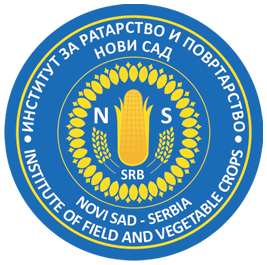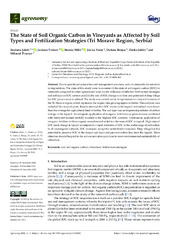The State of Soil Organic Carbon in Vineyards as Affected by Soil Types and Fertilization Strategies (Tri Morave Region, Serbia)
2021
Аутори
Jakšić, Snežana
Ninkov, Jordana

Milić, Stanko

Vasin, Jovica

Banjac, Dušana

Jakšić, Darko
Živanov, Milorad

Чланак у часопису (Објављена верзија)
Метаподаци
Приказ свих података о документуАпстракт
Due to specific soil properties and management practices, soils in vineyards are sensitive to degradation. The aims of this study were to examine (i) the state of soil organic carbon (SOC) in vineyards compared to other agricultural land, (ii) the influence of different fertilization strategies and soil type on SOC content and (iii) the rate of SOC change over time and potential of deep tillage for SOC preservation in subsoil. The study was carried out at 16 representative vineyard locations of the Tri Morave region, which represents the largest vine growing region in Serbia. The analyzed area included 56 vineyard plots. Results showed that SOC stocks in the topsoil and subsoil were lower than the average for agricultural land in Serbia. The soil type was an important predictor of carbon storage in the topsoil. An adequate application of inorganic fertilizers or green manure combined with farmyard manure initially resulted in the highest SOC contents. Continuous application of inorgani...c fertilizer without organic amendments has led to a decrease of SOC in topsoil. High rates of SOC stock change in topsoil accompanied a rapid reduction of SOC in the earlier stage of cultivation. In all investigated subsoils, SOC increased, except for unfertilized vineyards. Deep tillage has the potential to preserve SOC in the deeper soil layer and prevent carbon loss from the topsoil. More attention should be paid to the soil conservation practices to meet environmental sustainability of viticulture.
Кључне речи:
soil / soil organic carbon / viticulture / fertilization strategiesИзвор:
Agronomy-Basel, 2021, 11, 1Издавач:
- Basel : MDPI
Финансирање / пројекти:
- Ministry of Agriculture, Forestry and Water Management of the Autonomous Province of Vojvodina, Republic of Serbia [AAP 024]
- Министарство науке, технолошког развоја и иновација Републике Србије, институционално финансирање - 200032 (Научни институт за ратарство и повртарство, Нови Сад) (RS-MESTD-inst-2020-200032)
DOI: 10.3390/agronomy11010009
ISSN: 2073-4395
WoS: 000609657900001
Scopus: 2-s2.0-85108866464
Колекције
Институција/група
FiVeRTY - JOUR AU - Jakšić, Snežana AU - Ninkov, Jordana AU - Milić, Stanko AU - Vasin, Jovica AU - Banjac, Dušana AU - Jakšić, Darko AU - Živanov, Milorad PY - 2021 UR - http://fiver.ifvcns.rs/handle/123456789/2084 AB - Due to specific soil properties and management practices, soils in vineyards are sensitive to degradation. The aims of this study were to examine (i) the state of soil organic carbon (SOC) in vineyards compared to other agricultural land, (ii) the influence of different fertilization strategies and soil type on SOC content and (iii) the rate of SOC change over time and potential of deep tillage for SOC preservation in subsoil. The study was carried out at 16 representative vineyard locations of the Tri Morave region, which represents the largest vine growing region in Serbia. The analyzed area included 56 vineyard plots. Results showed that SOC stocks in the topsoil and subsoil were lower than the average for agricultural land in Serbia. The soil type was an important predictor of carbon storage in the topsoil. An adequate application of inorganic fertilizers or green manure combined with farmyard manure initially resulted in the highest SOC contents. Continuous application of inorganic fertilizer without organic amendments has led to a decrease of SOC in topsoil. High rates of SOC stock change in topsoil accompanied a rapid reduction of SOC in the earlier stage of cultivation. In all investigated subsoils, SOC increased, except for unfertilized vineyards. Deep tillage has the potential to preserve SOC in the deeper soil layer and prevent carbon loss from the topsoil. More attention should be paid to the soil conservation practices to meet environmental sustainability of viticulture. PB - Basel : MDPI T2 - Agronomy-Basel T1 - The State of Soil Organic Carbon in Vineyards as Affected by Soil Types and Fertilization Strategies (Tri Morave Region, Serbia) IS - 1 VL - 11 DO - 10.3390/agronomy11010009 ER -
@article{
author = "Jakšić, Snežana and Ninkov, Jordana and Milić, Stanko and Vasin, Jovica and Banjac, Dušana and Jakšić, Darko and Živanov, Milorad",
year = "2021",
abstract = "Due to specific soil properties and management practices, soils in vineyards are sensitive to degradation. The aims of this study were to examine (i) the state of soil organic carbon (SOC) in vineyards compared to other agricultural land, (ii) the influence of different fertilization strategies and soil type on SOC content and (iii) the rate of SOC change over time and potential of deep tillage for SOC preservation in subsoil. The study was carried out at 16 representative vineyard locations of the Tri Morave region, which represents the largest vine growing region in Serbia. The analyzed area included 56 vineyard plots. Results showed that SOC stocks in the topsoil and subsoil were lower than the average for agricultural land in Serbia. The soil type was an important predictor of carbon storage in the topsoil. An adequate application of inorganic fertilizers or green manure combined with farmyard manure initially resulted in the highest SOC contents. Continuous application of inorganic fertilizer without organic amendments has led to a decrease of SOC in topsoil. High rates of SOC stock change in topsoil accompanied a rapid reduction of SOC in the earlier stage of cultivation. In all investigated subsoils, SOC increased, except for unfertilized vineyards. Deep tillage has the potential to preserve SOC in the deeper soil layer and prevent carbon loss from the topsoil. More attention should be paid to the soil conservation practices to meet environmental sustainability of viticulture.",
publisher = "Basel : MDPI",
journal = "Agronomy-Basel",
title = "The State of Soil Organic Carbon in Vineyards as Affected by Soil Types and Fertilization Strategies (Tri Morave Region, Serbia)",
number = "1",
volume = "11",
doi = "10.3390/agronomy11010009"
}
Jakšić, S., Ninkov, J., Milić, S., Vasin, J., Banjac, D., Jakšić, D.,& Živanov, M.. (2021). The State of Soil Organic Carbon in Vineyards as Affected by Soil Types and Fertilization Strategies (Tri Morave Region, Serbia). in Agronomy-Basel Basel : MDPI., 11(1). https://doi.org/10.3390/agronomy11010009
Jakšić S, Ninkov J, Milić S, Vasin J, Banjac D, Jakšić D, Živanov M. The State of Soil Organic Carbon in Vineyards as Affected by Soil Types and Fertilization Strategies (Tri Morave Region, Serbia). in Agronomy-Basel. 2021;11(1). doi:10.3390/agronomy11010009 .
Jakšić, Snežana, Ninkov, Jordana, Milić, Stanko, Vasin, Jovica, Banjac, Dušana, Jakšić, Darko, Živanov, Milorad, "The State of Soil Organic Carbon in Vineyards as Affected by Soil Types and Fertilization Strategies (Tri Morave Region, Serbia)" in Agronomy-Basel, 11, no. 1 (2021), https://doi.org/10.3390/agronomy11010009 . .



